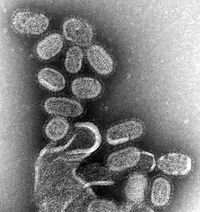
Influenza A Viruses in Peridomestic Mammals.
Sign Up to like & getrecommendations! Published in 2020 at "Methods in molecular biology"
DOI: 10.1007/978-1-0716-0346-8_32
Abstract: During recent years, serological evidence has shown that a number of peridomestic mammals (e.g., those commonly found in or around human structures) are naturally exposed to influenza A viruses (IAVs). In addition, experimental studies have… read more here.
Keywords: influenza viruses; biology; viruses peridomestic; iavs ... See more keywords

Low-Pathogenic Influenza A Viruses in North American Diving Ducks Contribute to the Emergence of a Novel Highly Pathogenic Influenza A(H7N8) Virus
Sign Up to like & getrecommendations! Published in 2017 at "Journal of Virology"
DOI: 10.1128/jvi.02208-16
Abstract: ABSTRACT Introductions of low-pathogenic avian influenza (LPAI) viruses of subtypes H5 and H7 into poultry from wild birds have the potential to mutate to highly pathogenic avian influenza (HPAI) viruses, but such viruses' origins are… read more here.
Keywords: diving ducks; influenza; h7n8; iavs ... See more keywords

Effects of Receptor Specificity and Conformational Stability of Influenza A Virus Hemagglutinin on Infection and Activation of Different Cell Types in Human PBMCs
Sign Up to like & getrecommendations! Published in 2022 at "Frontiers in Immunology"
DOI: 10.3389/fimmu.2022.827760
Abstract: Humans can be infected by zoonotic avian, pandemic and seasonal influenza A viruses (IAVs), which differ by receptor specificity and conformational stability of their envelope glycoprotein hemagglutinin (HA). It was shown that receptor specificity of… read more here.
Keywords: receptor specificity; infection; iavs; conformational stability ... See more keywords

Reassortment Network of Influenza A Virus
Sign Up to like & getrecommendations! Published in 2021 at "Frontiers in Microbiology"
DOI: 10.3389/fmicb.2021.793500
Abstract: Influenza A virus (IAV) genomes are composed of eight single-stranded RNA segments. Genetic exchange through reassortment of the segmented genomes often endows IAVs with new genetic characteristics, which may affect transmissibility and pathogenicity of the… read more here.
Keywords: reassortment network; iavs; influenza virus; network ... See more keywords